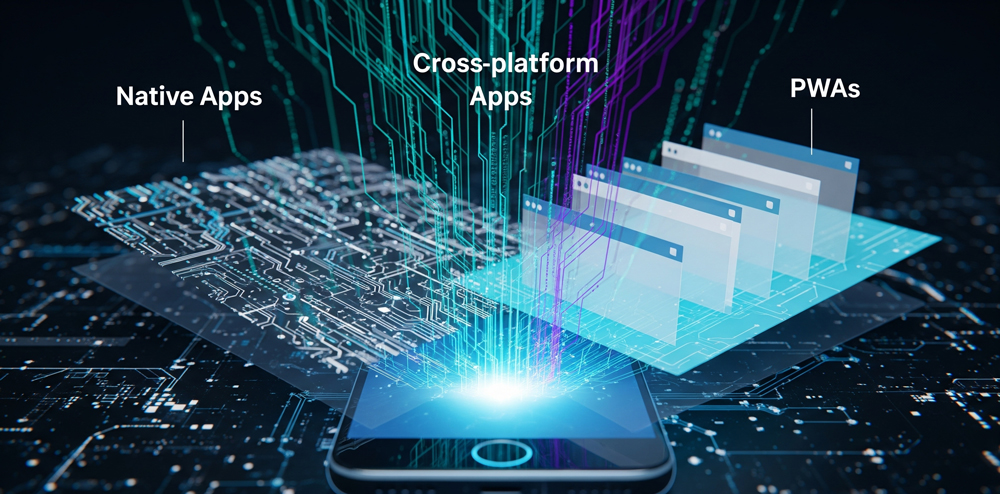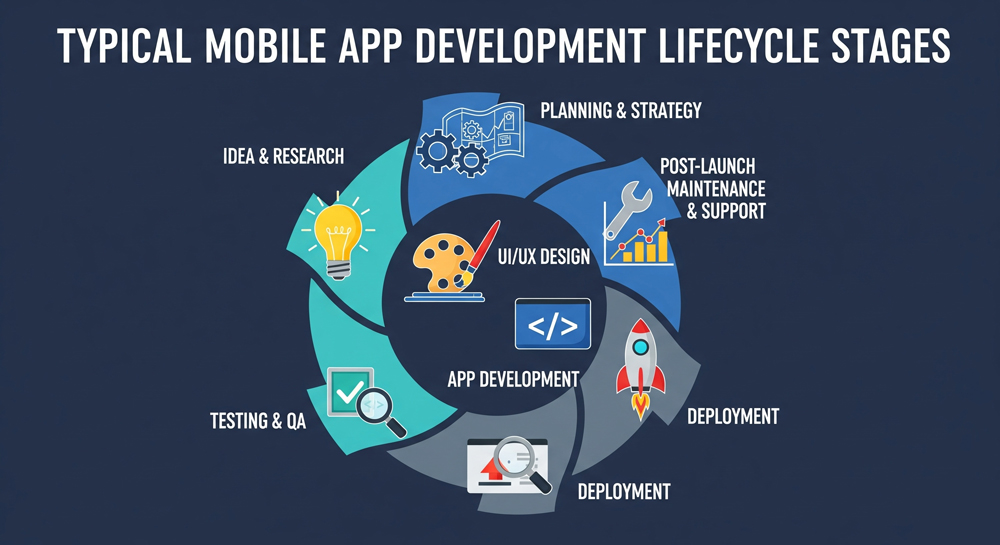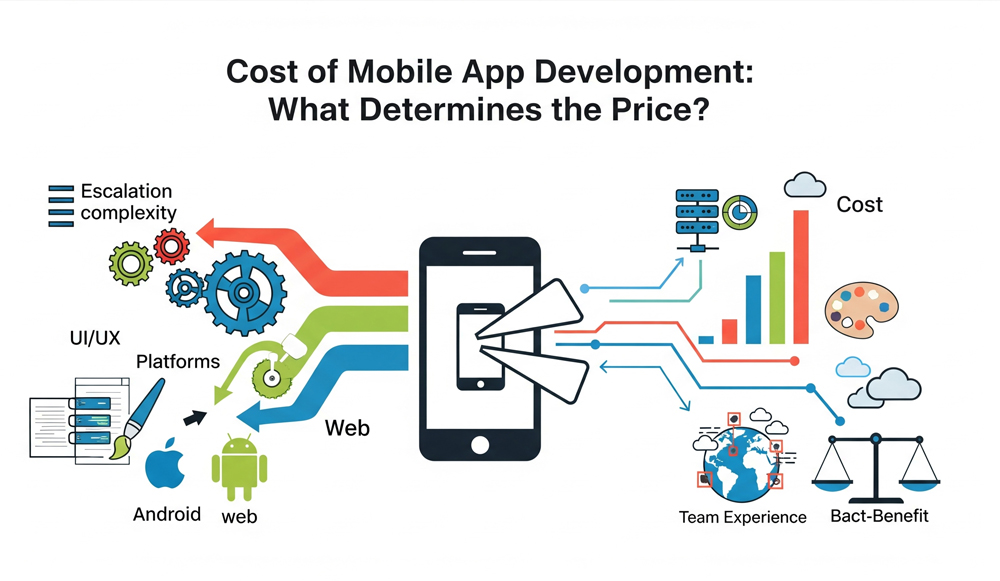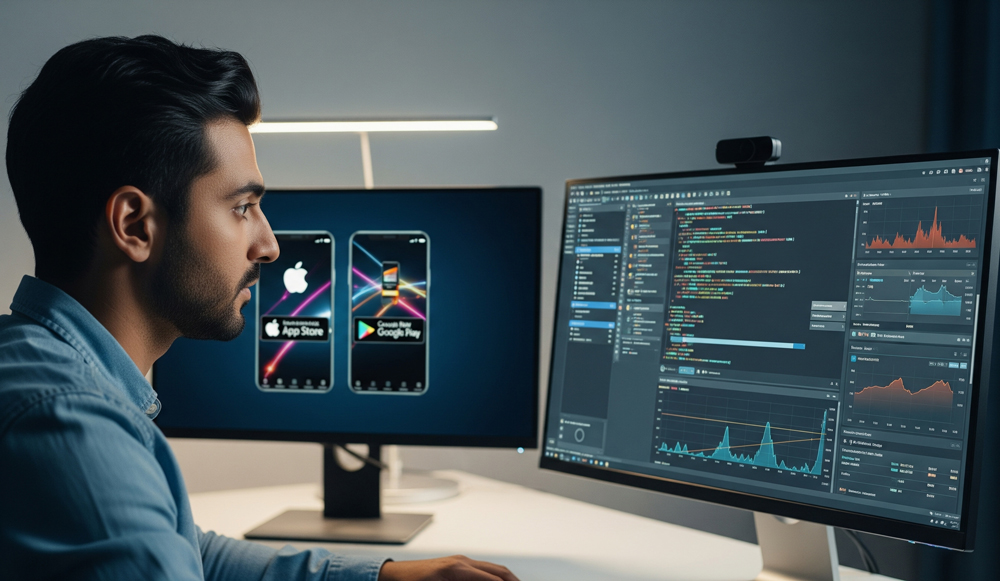
How to Choose the Best App Development Company in [Saudi Arabia/Middle East] in 2025? Your Comprehensive Guide to Digital Success
- Why Do You Need a Professional Mobile App for Your Business in 2025?
- Understanding Different Types of Mobile Apps and Their Advantages
- Typical Mobile App Development Lifecycle Stages
- Key Criteria for Choosing the Best App Development Company
- Modern Technologies and Trends in Mobile App Development 2025
- Cost of Mobile App Development: What Determines the Price?
- How to Effectively Research and Evaluate App Development Companies
- Models of App Development Companies That Excel in Specific Aspects
- Post-App Launch: Marketing, Maintenance, and Sustainable Growth
- Conclusion: Your Choice Today of an "App Development Company" Shapes Your Digital Future
In today's mobile-dominated world, and with the accelerating pace of digital transformation witnessed in the Middle East, particularly in Saudi Arabia in line with its ambitious Vision 2030, owning a professional mobile application is no longer a luxury. It has become a strategic necessity for companies seeking growth, enhanced customer engagement, and a strong brand identity. A skillfully designed and developed application can open new horizons for your business, increase your operational efficiency, and grant you a decisive competitive advantage.
However, with the increasing number of companies offering app development services, choosing the best app development company can seem like a daunting and confusing task. How can you ensure that you are putting your investment in the right place and selecting a partner capable of transforming your idea into a successful app that meets your business objectives and exceeds user expectations?
This comprehensive 2025 guide aims to provide you with in-depth knowledge, precise criteria, and practical steps to enable you to make an informed decision when choosing an app development company. We will delve into the details of app types, their development stages, modern technologies, factors affecting cost, and how to evaluate different companies to ensure you choose the optimal partner for your journey towards digital excellence.
“By the end of 2023, 64% of the population in the Middle East and North Africa region were subscribed to mobile services.”
GSMA Intelligence, The Mobile Economy Middle East and North Africa 2024
Why Do You Need a Professional Mobile App for Your Business in 2025?
Amidst the dominance of smartphones in our daily lives, a mobile app has become a direct and effective channel to communicate with your audience and provide them with added value. Statistics (according to recent industry reports) indicate that users in the Middle East and North Africa region spend increasing hours daily on mobile apps, and that app download and usage rates in sectors like e-commerce, services, and entertainment are witnessing tremendous growth. Investing in a professional mobile app grants your business significant competitive advantages, including:
- Increased Reach and Ease of Communication: A mobile app places your brand at your customers' fingertips around the clock, making it easier for them to access your services and products and interact with you directly.
- Enhanced Customer Loyalty and Experience: Apps can offer a customized and personalized user experience, build loyalty programs, and send instant notifications about offers and updates, thereby increasing customer engagement and fostering loyalty.
- Building a Strong and Distinctive Brand: A well-designed app reflects your brand identity and helps solidify its image in the public's mind as a modern and innovative brand.
- Opening New Revenue Channels: Apps can be a direct source of revenue through in-app sales, subscriptions, or even advertising (if suitable for your business model).
- Achieving a Competitive Advantage: In a crowded market, an innovative and user-friendly mobile app can distinguish you from your competitors and attract a larger segment of customers.
- Collecting Valuable Data on User Behavior: Apps provide accurate data on how users interact with your services, helping you better understand their needs and improve your products and marketing strategies.
- Improving Operational Efficiency: Apps can be used to automate some internal processes, facilitate communication with employees, or provide self-service options for customers, thereby reducing costs and improving efficiency.
Whether you are a startup seeking to make an impact, or an established company aspiring to expand its reach, ignoring the importance of mobile apps in 2025 could mean missing out on tremendous growth opportunities.
“By the end of 2023, 49% of the region's population used mobile internet, equivalent to about 327 million users.”
GSMA Intelligence, The Mobile Economy Middle East and North Africa 2024
Understanding Different Types of Mobile Apps and Their Advantages

Before you start searching for an app development company, it's important to have a basic understanding of the different types of applications available, as choosing the right type depends on your goals, budget, and target audience:
1. Native Apps:
These are applications developed specifically for a particular operating system, using the programming languages and tools specific to that platform (such as Swift or Objective-C for iOS, and Kotlin or Java for Android).
- Advantages:
- Superior performance and high responsiveness: Because they are built to make maximum use of the device's and operating system's capabilities.
- Optimal User Experience (UX): They fully comply with the design guidelines of each platform, making them familiar and easy for users to use.
- Full access to device features: Such as the camera, GPS, contact list, push notifications, etc.
- Often higher security.
- Disadvantages:
- Higher development cost: Requires building and maintaining separate codebases for each platform (iOS and Android).
- Longer development time.
- When are they suitable? For applications that require very high performance, complex graphics (like games), or intensive access to device features.
2. Cross-Platform Apps:
These are developed using a single programming language or framework (such as React Native, Flutter, Xamarin) through which an application can be built to run on multiple platforms (iOS and Android) using a largely shared codebase.
- Advantages:
- Lower development cost: Because you build one codebase for most parts of the application.
- Faster development time: Reaching the market is quicker.
- Relatively easier maintenance (for the shared code).
- Ability to reach a wider audience quickly.
- Disadvantages:
- Performance might be slightly lower than native apps in some cases, especially for applications with very complex graphics.
- Accessing some very advanced device features might require additional solutions or native code.
- User experience might not be 100% "native" for each platform, but modern frameworks have improved significantly in this aspect.
- When are they suitable? For most business applications, e-commerce applications, content applications, and applications that need to reach the market quickly with a reasonable budget.
3. Progressive Web Apps (PWAs):
These are essentially advanced websites built using modern web technologies (HTML, CSS, JavaScript) to function and provide an experience similar to mobile apps. They can be accessed via a web browser, can be installed on the device's home screen, and support features like partial offline operation and notifications.
- Advantages:
- No need for installation from app stores: Can be accessed directly via a web link.
- Compatible with all modern devices and browsers.
- Often lower development cost than native or cross-platform apps.
- Easy to update and maintain (centralized update).
- Benefits in terms of Search Engine Optimization (SEO) compared to traditional apps.
- Disadvantages:
- Limited access to some advanced device features compared to native apps.
- Support for PWA features might vary slightly between browsers and operating systems (especially iOS, which has been slower in supporting some features).
- May not be suitable for applications requiring very high graphical performance.
- When are they suitable? For content applications, simple tools, e-commerce stores, or as an addition to an existing website to provide a better mobile experience.
Understanding these differences will help you discuss your needs more effectively with the app development company and determine the most appropriate approach for your project.
| Type | Key Advantages | Key Disadvantages | When to Choose? |
|---|---|---|---|
| Native Apps | Superior performance, full access to device features, higher security | Higher cost and development time per platform | Games and complex graphics applications |
| Cross-Platform Apps | Single codebase, faster development time, lower cost | Slightly lower performance, may need native solutions for some features | Business and e-commerce applications |
| Progressive Web Apps (PWAs) | No installation needed, centralized update, better SEO | Limited access to device features, varied browser support | Lightweight content sites or an addition to a website |
Typical Mobile App Development Lifecycle Stages

Developing a successful mobile app is an organized process that goes through several essential stages, and each stage requires careful planning and meticulous execution. Here is an overview of these stages typically followed by the best app development companies:
- Idea & Research Stage:
- Clearly define the application idea and its main objectives.
- Study the target market and analyze competitors (What applications exist? What are their strengths and weaknesses?).
- Define the target audience for the application, their needs, and expectations.
- Determine the Unique Value Proposition your app will offer.
- Planning & Strategy Stage:
- Define the functional and non-functional requirements of the application in detail.
- Choose the appropriate platform(s) (iOS, Android, Cross-platform, PWA).
- Develop a project plan that includes budget, timeline, and required resources.
- Create wireframes to define the application structure and user flow.
- Develop interactive prototypes to test the idea and initial user experience.
- Define the monetization strategy for the application if appropriate.
- UI/UX Design Stage (User Interface & User Experience Design):
- Design visually attractive, modern user interfaces (UI) that are consistent with your brand identity.
- Focus on building an easy, intuitive, and enjoyable user experience (UX), considering cultural differences of the target audience (especially in the Middle East region).
- Follow platform-specific design guidelines (Apple Human Interface Guidelines for iOS and Material Design for Android) to ensure a familiar user experience.
- Create a Design System if the application is large to ensure consistency.
- App Development Stage:
- Frontend Development: Building the side that the user interacts with directly, using appropriate technologies for the chosen platform.
- Backend Development: Building servers, databases, and Application Programming Interfaces (APIs) that support the application's functions and store data (if the application requires it).
- Integrate any required third-party services (such as payment gateways, geographic location services, push notifications).
- Apply best practices for clean and secure programming.
- Testing & Quality Assurance Stage:
- Conduct comprehensive tests to detect and fix bugs and problems.
- This includes: functional testing, usability testing, performance testing, security testing, and compatibility testing with various devices and operating system versions.
- Conduct User Acceptance Testing (UAT) by the client to ensure the application meets all requirements.
- Deployment & Launch Stage:
- Prepare the application for deployment on app stores (App Store for iOS and Google Play for Android) or distribute it through other methods (such as Enterprise apps).
- Create developer accounts, prepare app metadata (name, description, images, keywords - ASO).
- Manage the application review process by app stores.
- Plan the launch strategy.
- Post-Launch Maintenance & Support Stage:
- Monitor application performance after launch and address any issues that arise.
- Release regular updates to fix bugs, improve performance, add new features, or support new operating system versions.
- Provide technical support to users or the client.
- Analyze application usage data to gather insights about user behavior and identify areas for improvement.
Close collaboration between you and your chosen app development company at every stage is key to developing a successful application that meets your objectives and achieves user satisfaction.
| Stage | Brief Description |
|---|---|
| 1. Idea and Research | Define idea, market study, competitor analysis, unique value |
| 2. Planning and Strategy | Gather requirements, choose platform, Wireframes and Prototypes |
| 3. UI/UX Design | Design attractive interfaces and a seamless user experience |
| 4. Development | Frontend and backend programming, third-party service integration |
| 5. Testing and Quality Assurance | Functional, performance, security, device compatibility tests |
| 6. Deployment and Launch | App Store/Play Store setup, ASO, store review |
| 7. Post-Launch Maintenance and Support | Regular updates, bug fixes, adding features, technical support |
“71% of survey respondents said they use Agile methodology within their software development lifecycle.”
— Digital.ai, 17th State of Agile Report
Key Criteria for Choosing the Best App Development Company

Choosing the right technology partner to develop your mobile app is a crucial decision. Here is a set of key criteria that you should consider when evaluating app development companies to ensure you choose the best for your project:
- Portfolio and Case Studies:
Ask to see previous applications the company has developed, especially those similar to your idea or in the same business sector. Don't just rely on images; try to test the applications if possible. Look for case studies that demonstrate how the company contributed to its clients' success and what results were achieved (such as number of downloads, user ratings, return on investment).
- Technical Expertise & Team:
Ensure the company has a specialized team with experience in the technologies and platforms you need (iOS, Android, React Native, Flutter, Swift, Kotlin, Java, etc.). Ask about the experience of the developers, designers, project managers, and quality testers. Do they keep up with the latest technological advancements?
- Ability to Design Outstanding User Interface and User Experience (UI/UX Design Capabilities):
Attractive design and ease of use are key to the success of any application. Ensure the company has a strong UI/UX design team, with a deep understanding of user-centered design principles, and capable of creating intuitive and visually appealing interfaces that suit your target audience (taking into account cultural specificities if you are targeting specific markets like Saudi Arabia or the Middle East).
- Development Process & Project Management Methodology:
Ask about the development methodology they follow (such as Agile or Scrum). How do they manage projects? How is communication handled and how will you be updated on the latest developments? Transparency and organized processes are very important to ensure the project proceeds smoothly and within the timeline.
- Deep Understanding of Your Industry & Target Audience:
A company with previous experience in developing applications for your business sector or for an audience similar to yours will be better able to understand your needs and provide effective solutions. If you are targeting the Saudi market, for example, their understanding of the local culture and Saudi user behaviors is a significant advantage.
- Security & Data Protection Practices:
Ensure the company follows best practices for secure programming and takes user data security seriously, especially if your application will handle sensitive information or financial transactions. Ask about how they secure the application and servers and comply with regulations such as PDPL in Saudi Arabia or GDPR.
- Post-Launch Support & Maintenance Services:
Application development does not end with its launch. Ensure the company offers clear support and maintenance plans to update the application, fix bugs, and provide technical support when needed. Discuss the details of the Service Level Agreement (SLA).
- Pricing Models & Cost Transparency:
Request a detailed and clear price quote. Understand the pricing model they use (fixed price for the project, hourly rate, or value-based model). Ensure there are no hidden costs, and discuss how to handle any changes in the scope of work that might affect the cost.
- Client Testimonials & References:
Do not hesitate to ask to speak with previous clients of the company to get a direct assessment of their experience. Positive reviews and credible testimonials are strong evidence of the company's quality of work and credibility.
- Communication & Collaboration:
Communication with the company's team should be easy and effective. Are they responsive to your inquiries? Do they speak your language (or a common language) fluently? Do you feel they are true partners in your project?
- Scalability of Solutions:
Can the application they develop grow and expand with your business and increasing number of users without major problems or the need to rebuild everything from scratch?
- Location and Cultural Fit:
| Criterion | What to look for |
|---|---|
| Portfolio | Applications similar to your sector, case studies with clear results |
| Technical Expertise | Experience in required technologies (iOS, Android, Flutter…) |
| UI/UX | Quality of designs, user workshops, consistent design system |
| Methodology | Agile/Scrum, tracking tools (Jira, Trello…) |
| Security & Data Protection | Encryption, security testing, PDPL/GDPR/KVKK compliance |
| Support & Maintenance | Clear SLA, regular updates, quick response |
| Cost Transparency | Detailed pricing model, scope change limits |
| Cultural Compatibility | Understanding of the local market, communication in appropriate languages |
Sometimes, it might be beneficial to work with a company that is geographically close or has a deep understanding of your culture and local market, which facilitates communication and collaboration. However, many global companies offer excellent services remotely.
Choosing the best app development company based on these criteria will set your project on the right path to success.
Modern Technologies and Trends in Mobile App Development 2025

“It is expected that AI features will become an essential part of mobile app development by 2025 to enhance personalization, security, and user experience.”
— Cloudester, 7 Ways AI is Transforming Mobile App Development in 2025
The world of mobile app development is constantly evolving. To stay at the forefront and deliver innovative applications that meet user expectations, it is important that the app development company you choose is aware of the latest technologies and trends. Here are some of the most prominent for 2025 and beyond:
- Artificial Intelligence and Machine Learning (AI & ML) Integrated into Applications:
- Hyper-personalization of the user experience.
- Smart chatbots for customer service.
- Analysis of user behavior to provide accurate recommendations.
- Image and voice recognition, and Natural Language Processing (NLP) within applications.
- Internet of Things (IoT) Applications and Connectivity with Smart Devices:
- Applications for controlling smart home devices, wearables, and connected cars.
- Collecting data from IoT sensors and analyzing it to provide valuable insights.
- Augmented Reality (AR) and Virtual Reality (VR) Experiences via Mobile:
- AR applications for virtual product try-ons (such as furniture or clothing).
- Immersive games and educational experiences using VR and AR.
- Innovative filters in social media applications.
- Impact of 5G Networks:
- Higher internet speeds and lower latency, enabling richer and more interactive experiences (such as high-definition video streaming, cloud gaming on mobile).
- Applications that require transferring large amounts of data in real-time.
- Enhanced Mobile App Security:
- Increased focus on protecting user data and privacy.
- Wider use of biometric authentication technologies (fingerprint, facial recognition).
- Advanced data encryption and proactive threat detection.
- Continuous Development in Cross-Platform App Development:
- Frameworks like Flutter and React Native have become more mature and powerful, offering performance very close to native applications while saving time and cost.
- Emergence of "Super Apps" and Mini-Apps:
- A trend emerging in some markets (especially in Asia) towards applications that offer a wide range of diverse services within a single platform.
- Applications Supporting Voice Commands and Voice User Interfaces (VUI):
- The increasing use of voice assistants is driving the development of applications that can be controlled and interacted with vocally.
- Ethical & Sustainable App Design:
- Focus on designing applications that are not addictive, respect user privacy, and consider device battery consumption and resources in general.
The company capable of understanding these trends and applying them effectively is the one that will help you build an innovative and future-proof mobile application.
Cost of Mobile App Development: What Determines the Price?

The cost of developing a mobile app is one of the most important factors that companies consider. There is no fixed and uniform price, as the cost varies greatly based on a set of intertwined factors. Understanding these factors will help you estimate a realistic budget for your project:
- App Complexity & Features:
- A simple application with basic features (such as displaying information, a contact form) will be much less expensive than a complex application that includes features like login, user accounts, integration with third-party services, financial transactions, geolocation, push notifications, live chat, or the use of technologies like AI or AR.
- Each additional feature requires time and effort in design, programming, and testing, thus increasing the cost.
- Target Platform(s):
- Developing a native application for iOS only or Android only will be less costly than developing two separate native applications for both systems.
- Developing a cross-platform application may be a compromise in terms of cost, but it depends on the complexity of the application and its need to access native device features.
- Quality and Complexity of UI/UX Design:
- A custom and unique design (Custom UI/UX Design) requires greater creative effort and will be more expensive than using ready-made design templates or a simple design. Advanced animations and complex interactive elements also increase the cost.
- Backend Development & Server Infrastructure:
- If your application needs to store user data, manage centralized content, or perform complex operations on the server, you will need to develop a strong and scalable backend. The cost of this depends on its complexity and the technologies used (such as the type of database, server programming language, and cloud hosting platform).
- Integration with Third-Party APIs:
- If your application needs to integrate with other services (such as payment gateways, Google Maps, social media platforms, ERP/CRM systems), the cost of this integration depends on the complexity of the API and the ease of dealing with it.
- Location and Expertise of the Development Team:** **
| Technology/Trend | Benefit | Application Examples |
|---|---|---|
| Artificial Intelligence & Machine Learning (AI & ML) | Personalization, smart recommendations, Chatbots | Product recommendations, automated support |
| Internet of Things (IoT) | Connecting devices and collecting live data | Smart home control |
| Augmented and Virtual Reality (AR/VR) | Immersive experiences, virtual product try-on | Virtual furniture try-on |
| 5G Networks | High speeds, low latency | High-definition video streaming |
| Cross-Platform Apps (Flutter/React Native) | Shared code and near-native performance | Content and business apps |
| Super Apps and Mini-Apps | Comprehensive platform for multiple services | WeChat-style applications |
| Voice User Interfaces (VUI) | Voice control and voice interaction | Integrated voice assistants |
| Ethical and Sustainable Design | Respecting user privacy and lower resource consumption | Battery-friendly applications |
General Estimated Price Ranges (For Guidance Only):
Disclaimer: These are very general estimates and may vary significantly based on the factors mentioned above and the requirements of each project. To get an accurate price quote, you should always contact app development companies and provide detailed requirements for your project.
| Application Type | Price Range (Saudi Riyal - SAR) |
|---|---|
| MVP – Simple Application | 5,000 – 15,000 |
| Moderately Complex Application | 20,000 – 40,000 |
| Very Complex Application or Games/Enterprise | ≥ 100,000 |
- Simple application (MVP - Minimum Viable Product) with basic features: May range between 5,000 - 15,000 Saudi Riyals.
- Moderately complex application (such as an e-commerce application or a service application with user accounts): May range between 20,000 - 40,000 Saudi Riyals.
- Very complex application (such as a large social networking application, an advanced gaming application, or an enterprise application with advanced features): May start from 100,000 Saudi Riyals and reach hundreds of thousands or even millions.
Important Tip: When requesting price quotes, make sure you provide the same requirements to all companies and that the quotes you receive are detailed and clarify what is included and what is not included in the price.
- The cost of app development services varies significantly between countries and regions. Companies in Western European or North American countries often have higher prices than companies in other regions. Team experience and company size also play a role.
How to Effectively Research and Evaluate App Development Companies

After defining your needs and understanding the types of applications and expected costs, the stage of searching for and evaluating a suitable app development company begins. Here are some practical steps you can follow:
- Start with Initial Research and Compile a List of Potential Companies:
- Use search engines with specific keywords (such as "app development company in Riyadh," "best iOS app developers in Jeddah," "Flutter app development in the Middle East").
- Browse global and local company review platforms (such as Clutch, GoodFirms, AppFutura, and possibly local platforms if available).
- Ask for recommendations from your network, especially from entrepreneurs or companies that have developed successful applications.
- Search on LinkedIn for companies active in this field in your target region.
- Create a Shortlist Based on Initial Criteria:
- Review the portfolios of companies on your initial list. Do they have experience in the type of application you want or in your business sector?
- Does the quality of their designs and previous work look professional?
- Do they have positive client testimonials?
- (Exclude companies that clearly do not seem suitable).
- Prepare a Project Brief or Request for Proposal (RFP):
This brief should include: the application idea, objectives, target audience, basic features required, target platforms (iOS, Android), and any special technical or design requirements, in addition to your estimated budget and expected timeline (if possible).
- Contact the Companies on Your Shortlist:
Send them your project brief and ask them to provide a technical and financial proposal. This is your first opportunity to assess their professionalism and speed of response.
- Ask the Right Questions During Meetings and Discussions:
(Refer to the "Key Criteria for Choosing the Best App Development Company" section for a list of important questions to ask).
- Evaluate Price Quotes and Proposals Very Carefully:
- Do not compare based on price alone. Look at the total value offered.
- Is the proposal detailed, clear, and does it cover all aspects of your project?
- Are the proposed timeline and methodology realistic?
- What are the payment terms and intellectual property rights?
- Check References and Talk to Previous Clients:
This is an indispensable step. Ask the shortlisted companies for a list of previous clients you can contact directly and ask about their experience.
- Assess the "Chemistry" and Compatibility with the Company's Team:
You will be working with this team for a long time. Do you feel comfortable communicating with them? Do they seem to understand your vision and are they enthusiastic about your project?
Following an organized evaluation process will help you avoid many future problems and choose a technology partner who truly contributes to the success of your application.
Models of App Development Companies That Excel in Specific Aspects
Important Disclaimer: This section aims to illustrate how some companies can specialize and excel in specific aspects of application development. The companies or patterns mentioned are for illustrative purposes and do not represent an exhaustive list or an absolute preference. Every reader should conduct their own research and careful evaluation based on their unique needs.
When searching for an app development company, you may find that some focus on certain aspects more than others. Here are some "patterns" or "models" of companies you might encounter:
1. Model One: "The Comprehensive Strategic Partner for App Development"
- Description: These companies are not limited to programming only; they offer comprehensive strategic consulting, starting from developing the app idea, through market research, user experience design, development, testing, and even assistance with marketing, launch, and post-launch growth strategies.
- Strengths: A comprehensive view of the app lifecycle, focus on achieving business goals, ability to provide integrated solutions.
- How to identify them: Look for companies with diverse teams (strategists, UX designers, developers, marketers), and showcase case studies that demonstrate their full impact on the success of the apps they developed.
- Example of this approach: Syrian Coders, with our extensive experience since 2013 and our deep understanding of Middle Eastern markets, we always strive to be this strategic partner. We don't just program the app; we provide consultations and build integrated solutions that ensure the success of your app in vital markets such as Saudi Arabia, Turkey, and the Gulf.
2. Model Two: "The Specialist in Specific Technologies or Platforms"
- Description: Companies that focus deeply on a specific technology (like Flutter or React Native for cross-platform apps) or a specific platform (like developing native iOS apps only).
- Strengths: Very deep expertise in the chosen technology or platform, which may lead to higher quality and better efficiency in that specific area.
- How to identify them: Look at their portfolio, which should heavily focus on this technology, and any certifications or partnerships they might have with providers of these technologies.
- Example of this approach (as a general illustrative example): A company like "Madar Solutions" might stand out in providing solutions based on specific technologies if that is within their declared specializations, or other companies in Riyadh that focus exclusively on developing game apps using Unity.
3. Model Three: "Industry Niche Specialist"
- Description: Companies with extensive and specialized experience in developing applications for a specific sector (such as healthcare apps, Fintech, education, real estate, or e-commerce for specific products).
- Strengths: Deep understanding of the challenges and opportunities of this sector, knowledge of its specific regulations and standards, and the ability to build solutions that accurately meet the needs of users in this sector.
- How to identify them: Look for a portfolio that focuses on projects in your sector, client testimonials from companies in the same field, and content (articles, studies) that demonstrates their expertise in this sector.
4. Model Four: "UI/UX-First Design Studio"
- Description: These companies or studios place the greatest emphasis on exceptional user interface and user experience design as a top priority, considering great design as the key to app success. They often have very talented designers and follow in-depth design processes.
- Strengths: Applications with very high aesthetics, intuitive and enjoyable user experiences, focus on design innovation.
- How to identify them: Look at the quality of designs in their portfolio, awards they may have received in design, and their methodology in the design process and user research.
When choosing an app development company, consider which of these models (or a combination of them) best suits the nature of your project and your priorities.
Post-App Launch: Marketing, Maintenance, and Sustainable Growth

Launching your app in app stores is not the end of the road, but rather the beginning of a new and crucial stage. To ensure your app's success and sustainable growth, you must have a clear post-launch strategy that includes:
- App Store Optimization (ASO):
- Choosing an attractive title and an accurate description for the app that includes appropriate keywords.
- Using high-quality images, screenshots, and videos that attractively showcase the app's features.
- Choosing the appropriate category and correct keywords within the store.
- Encouraging users to leave positive ratings and reviews.
- App Marketing Strategies:
- Marketing via social media.
- Paid advertising campaigns (Google Ads for Apps, Apple Search Ads, ads on social media platforms).
- Content marketing (blog, videos explaining the app's benefits).
- Influencer Marketing.
- Public relations and communication with tech media.
- Collecting and Analyzing User Feedback & Analytics:
- Monitoring user ratings and reviews on app stores and responding to them.
- Using tools to analyze user behavior within the app (such as Google Analytics for Firebase, Mixpanel) to understand how they use the app and identify weaknesses or opportunities for improvement.
- Providing easy channels for users to submit their feedback and suggestions.
- Regular Updates & Maintenance:
- Issuing regular updates to fix any bugs that appear.
- Improving app performance and compatibility with new operating system versions and modern devices.
- Adding new features based on user feedback or market developments.
- Reviewing and updating security measures periodically.
- Monetization Strategies - if applicable:
- If your app relies on a monetization model (such as subscriptions, in-app purchases, ads), monitor its performance and optimize it continuously.
- Building a Community Around Your App:
- Interacting with users on social media or through dedicated forums, and encouraging them to share their experiences.
Many distinguished app development companies offer consulting services or support in some of these post-launch aspects, or can direct you to specialized partners in app marketing.
Conclusion: Your Choice Today of an "App Development Company" Shapes Your Digital Future
The decision to choose an app development company is a strategic investment that can determine the success trajectory of your digital project for years to come. In the modern business world, which increasingly relies on technology and effective digital presence, a skillfully designed and developed mobile app becomes an indispensable tool for communicating with your audience, providing added value, and achieving your business goals.
We hope this comprehensive guide has provided you with in-depth knowledge, clear criteria, and practical steps that enable you to navigate the app development market with confidence, wisely evaluate available options, and choose the optimal technology partner who not only possesses the technical skills but also understands your vision, shares your ambitions, and is committed to your success. Always remember that the right partner is the one who helps you transform your idea into a successful and impactful application in users' lives.
We wish you all the best in your journey towards building an innovative mobile app that contributes to the growth of your business and achieves leadership in today's fast-paced digital world.
Would you like to have coffee with us?
From free consultation to a complete project plan, we are with you at any time to start a fruitful collaboration and make your digital assets a unique dashboard.